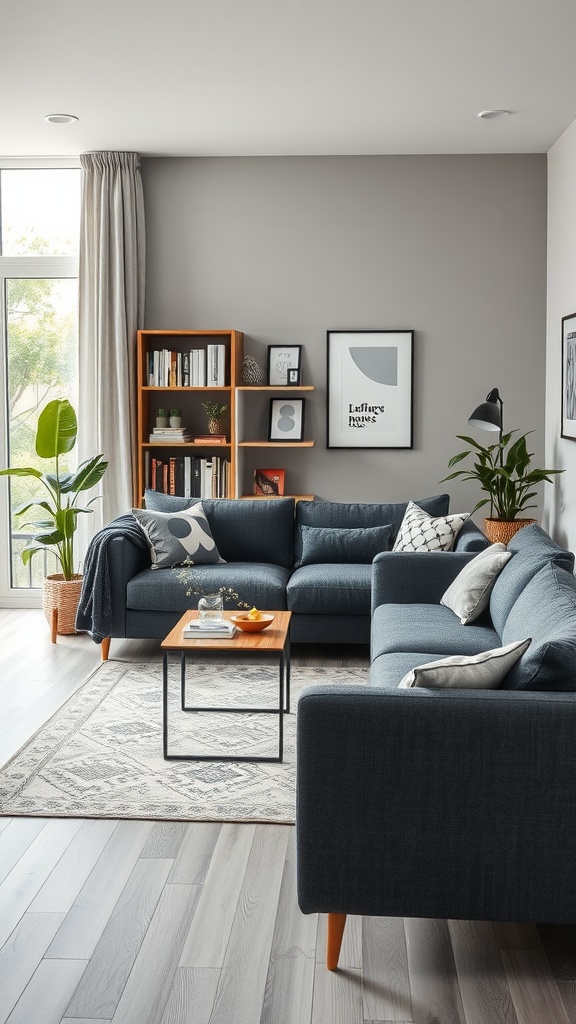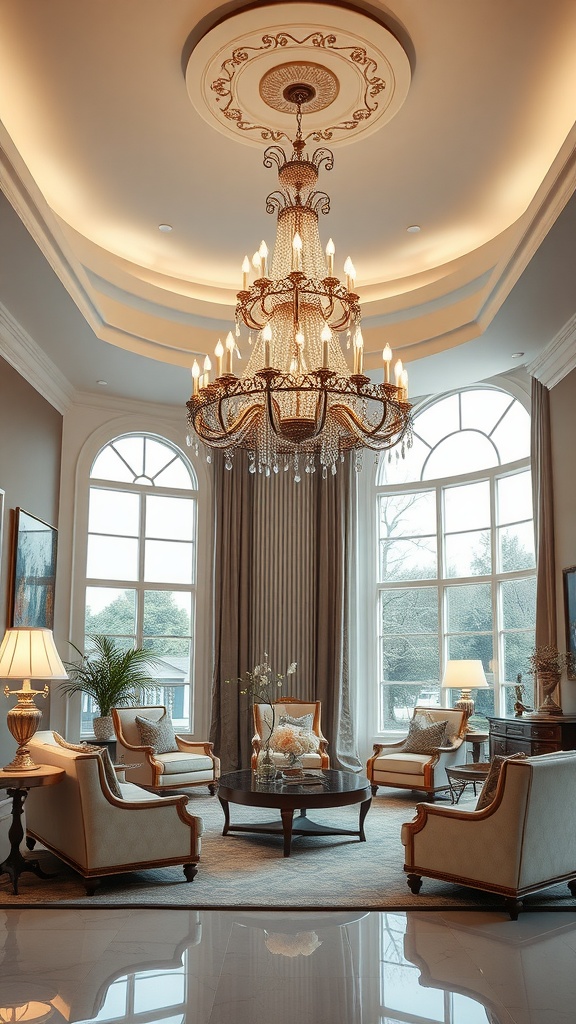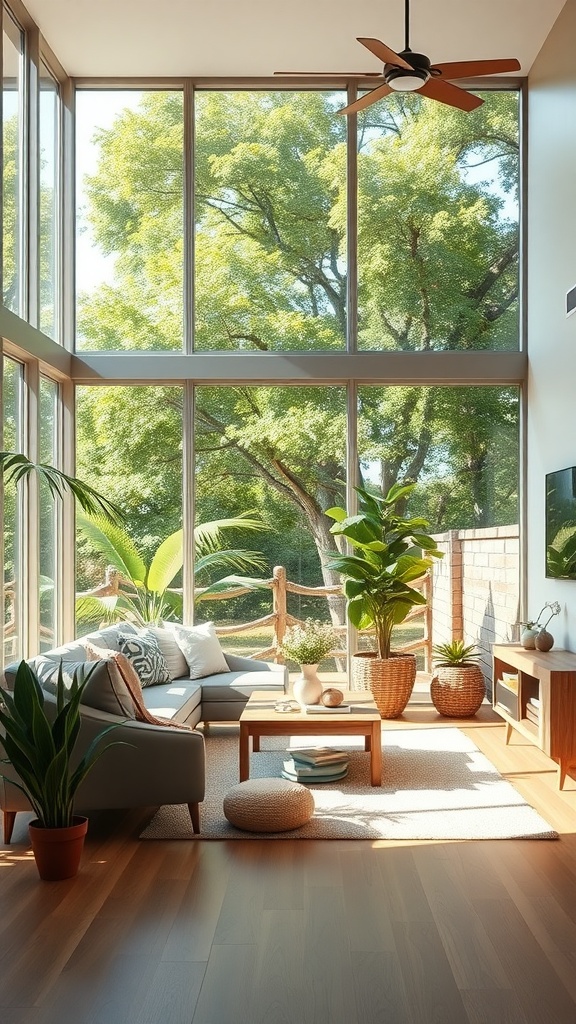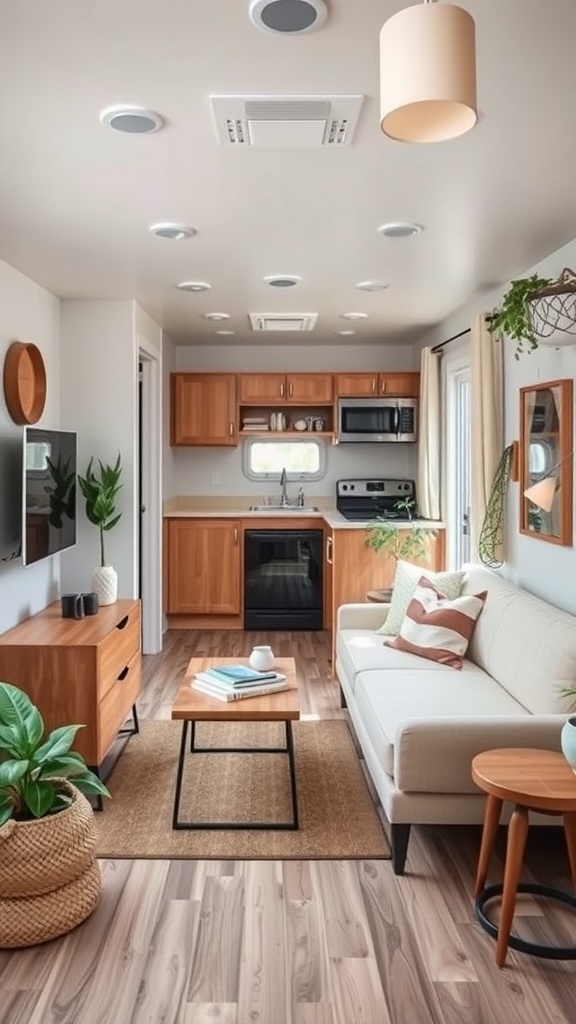Minimalist living rooms are all about creating a stylish yet clutter-free space that feels open and inviting. With clean lines, neutral colors, and functional furniture, this approach helps you focus on what truly matters, turning your living area into a peaceful retreat. Let’s take a look at some great ideas for embracing minimalist design in your home!
Embracing Neutral Color Palettes
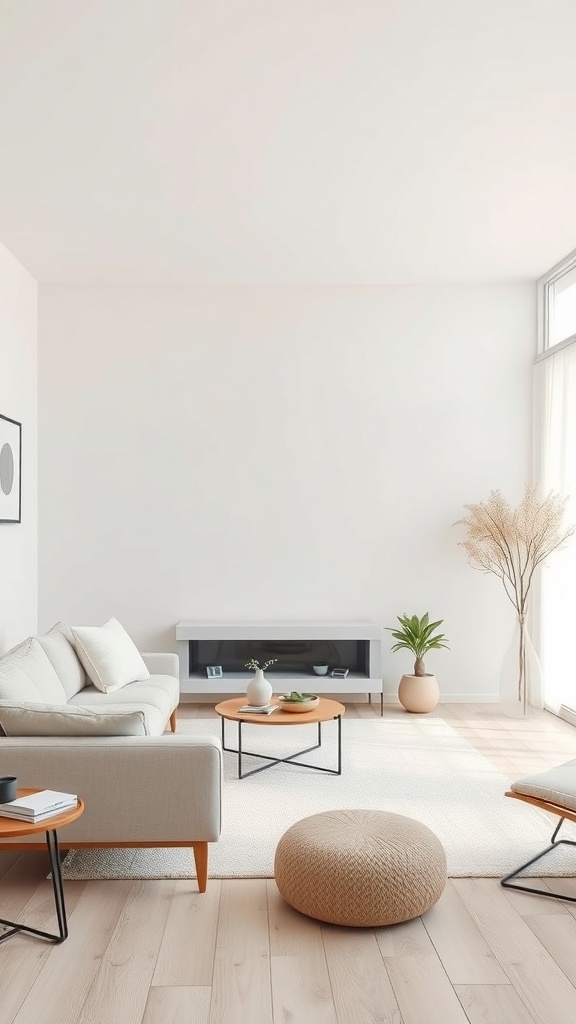
Neutral color palettes are a key feature in minimalist living rooms. They create a calm and inviting space. The image shows a bright room with soft whites and light wood tones. This combination makes the area feel open and airy.
The furniture is simple yet stylish. A light-colored sofa sits comfortably, paired with wooden tables that add warmth. The round pouf offers extra seating without cluttering the space. Plants bring a touch of nature, enhancing the serene vibe.
Using neutral colors allows for easy coordination with decor. You can add pops of color through accessories like cushions or art pieces. This flexibility keeps the room feeling fresh and personalized.
Overall, a neutral palette in a minimalist living room promotes relaxation and simplicity. It’s a perfect backdrop for both quiet moments and lively gatherings.
Incorporating Natural Light
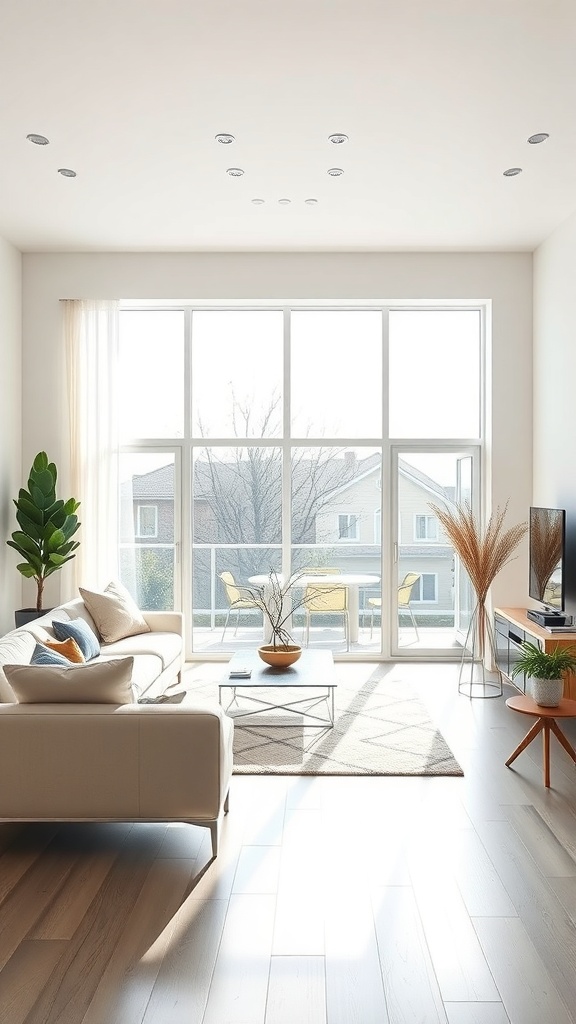
Natural light can transform a minimalist living room into a warm and inviting space. The large windows in this room let in plenty of sunlight, creating a bright atmosphere. This openness makes the room feel larger and more spacious.
The light reflects off the light-colored walls and wooden floors, enhancing the clean lines and simple design. A few carefully chosen plants add a touch of greenery, bringing life to the space without cluttering it.
Using sheer curtains allows for privacy while still letting in that beautiful daylight. This balance is key in minimalist design, where simplicity meets functionality. The overall effect is calming and refreshing, perfect for relaxing or entertaining.
Textured Fabrics for Warmth
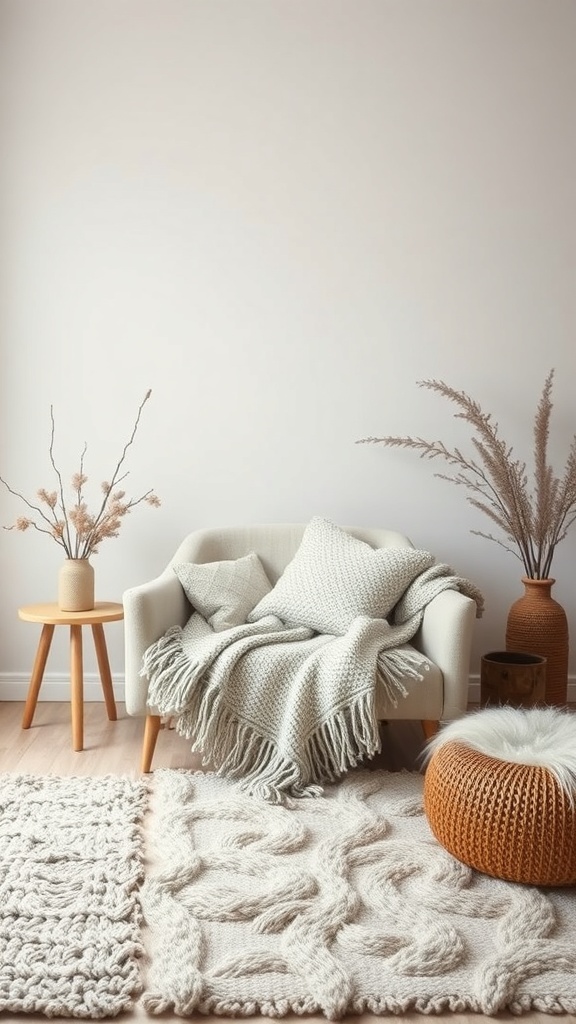
In a minimalist living room, textures play a key role in creating warmth and comfort. The image showcases a cozy setup featuring a soft, knitted blanket draped over a simple sofa. This inviting touch adds a layer of comfort that contrasts beautifully with the clean lines of minimalist design.
The use of various fabrics, like the chunky knit of the blanket and the plush rug beneath, brings depth to the space. The rug’s intricate pattern adds visual interest, making the room feel more inviting. This combination of textures can transform a stark environment into a cozy retreat.
Natural elements, like the dried flowers in a vase and the woven pouf, further enhance the warmth. These pieces not only add character but also create a sense of connection to nature. Incorporating such elements can make a minimalist living room feel more lived-in and welcoming.
Artful Minimalist Decor
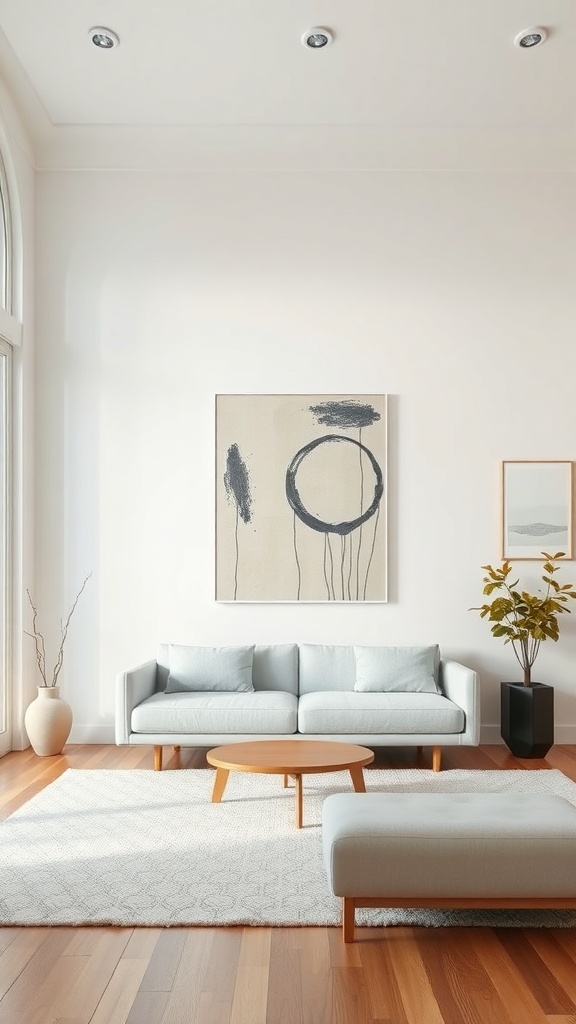
In a minimalist living room, every piece serves a purpose. The image showcases a serene space with a light color palette and simple lines. The soft, muted tones create a calm atmosphere, perfect for relaxation.
The focal point is the art on the wall. Its abstract design adds character without overwhelming the space. This kind of artwork complements minimalist decor beautifully, allowing for personal expression while keeping things tidy.
The furniture is sleek and functional. The light gray sofa and round wooden coffee table blend seamlessly with the room’s overall aesthetic. A cozy rug ties everything together, adding warmth to the wooden floor.
Plants are a great addition to minimalist spaces. They bring life and a touch of nature indoors. In this room, the greenery contrasts nicely with the neutral tones, making the space feel inviting.
Functional Furniture Choices
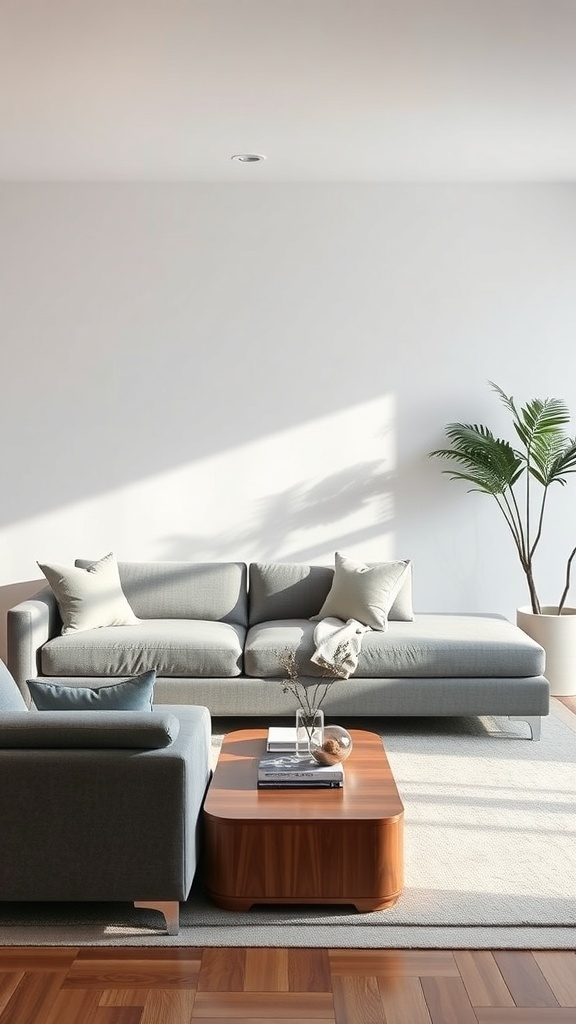
In a minimalist living room, every piece of furniture plays a vital role. The image showcases a cozy setup with a sleek sofa and a stylish coffee table. This combination not only looks good but also serves practical purposes.
The sofa, with its clean lines and neutral color, invites relaxation. It’s perfect for lounging or entertaining guests. The cushions add comfort without overwhelming the space. A minimalist approach often means choosing fewer pieces that make a statement.
The coffee table stands out with its unique shape and warm wood finish. It offers a place for drinks, books, or decorative items, keeping the area functional yet stylish. This balance is key in minimalist design.
Incorporating plants, like the one seen in the corner, brings a touch of nature indoors. It adds life to the room without cluttering it. Overall, functional furniture choices enhance the room’s simplicity while ensuring it remains inviting.
Indoor Plants for Freshness
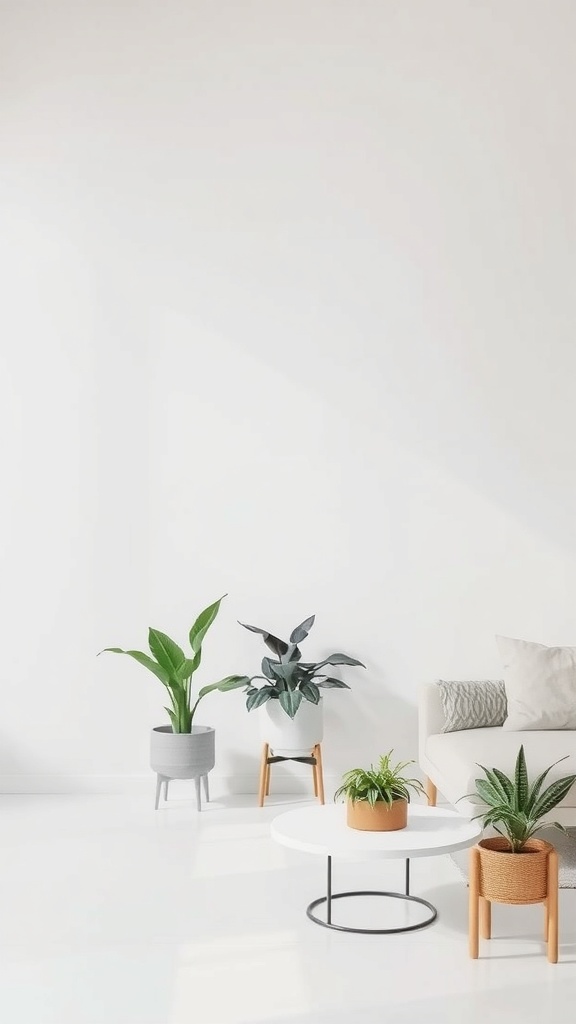
Indoor plants can bring a refreshing vibe to any minimalist living room. In the image, you can see a bright and airy space with a few carefully chosen plants. They add life and color without overwhelming the simplicity of the decor.
The plants are placed in stylish pots that complement the clean lines of the furniture. A mix of greenery, like the tall leafy plant and the smaller succulent, creates a balanced look. This variety not only enhances the aesthetic but also contributes to a calming atmosphere.
Choosing the right plants is key. Low-maintenance options like snake plants or pothos are perfect for busy lifestyles. They thrive in various lighting conditions and require minimal care. Plus, they help purify the air, making your living space feel even fresher.
Incorporating plants into your living room design is a simple way to elevate the space. They can act as focal points or subtle accents, depending on your style. So, whether you’re a seasoned plant parent or just starting out, adding greenery can transform your minimalist living room into a cozy retreat.
Open Floor Plan Integration
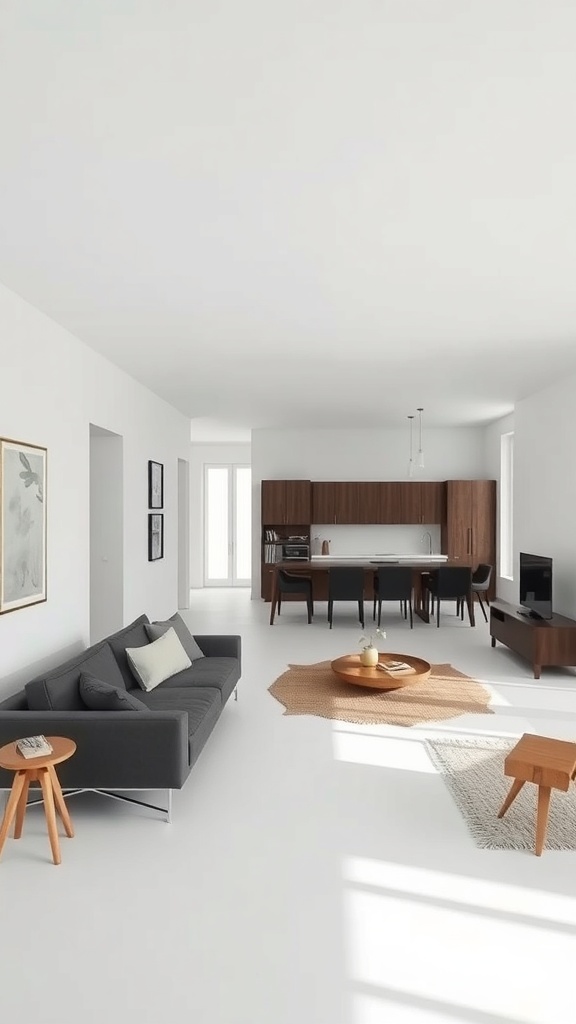
Open floor plans are a fantastic way to create a spacious feel in your living area. This minimalist living room showcases how an open layout can seamlessly connect different spaces. The smooth transition from the living room to the kitchen makes the area feel larger and more inviting.
The choice of furniture is key in this design. The sleek gray sofa and simple wooden tables complement the light color scheme, enhancing the airy vibe. The round coffee table adds a touch of warmth, while the natural textures of the rugs ground the space.
Natural light pours in through large windows, making the room feel bright and cheerful. This openness encourages social interaction, making it perfect for gatherings or simply enjoying a quiet moment. The minimalist decor keeps distractions at bay, allowing the beauty of the space to shine.
Incorporating an open floor plan can transform your home into a cozy yet stylish retreat. It’s all about balancing functionality with aesthetics, and this living room does just that.
Decluttering for Serenity
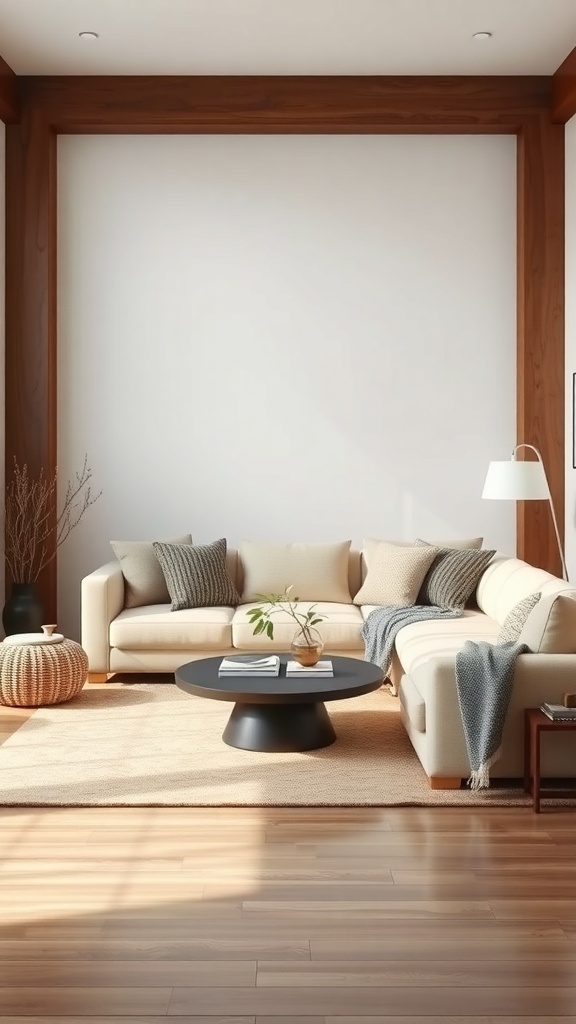
A minimalist living room is a perfect example of how decluttering can create a serene space. The image showcases a cozy area with soft, neutral tones and simple furniture. The light streaming in adds warmth, making it inviting.
The sectional sofa, adorned with a few textured pillows, encourages relaxation without overwhelming the senses. The round coffee table keeps things functional yet stylish, while the natural elements, like the small plant, bring a touch of life to the room.
Every item in this space has a purpose, contributing to a calm atmosphere. The absence of clutter allows for a clear mind, making it easier to unwind after a long day. This approach to living encourages us to cherish what we have and focus on quality over quantity.
Sustainable Material Choices

In a minimalist living room, every piece of furniture tells a story. The image showcases a cozy setup with natural materials that create a warm and inviting space. The wooden elements, like the coffee table and chairs, highlight the beauty of sustainable choices. Using wood from responsibly managed forests not only looks great but also supports eco-friendly practices.
The soft textiles, like the throw blanket, add comfort while being mindful of the environment. Choosing organic cotton or recycled materials for cushions and throws can make a big difference. These choices reflect a commitment to sustainability without sacrificing style.
Plants in the room bring life and freshness. They also improve air quality, making the space healthier. Incorporating greenery is a simple way to enhance your living area while being eco-conscious. Overall, this minimalist approach emphasizes that you can create a beautiful home with sustainable materials that are kind to the planet.
Minimalist Window Treatments
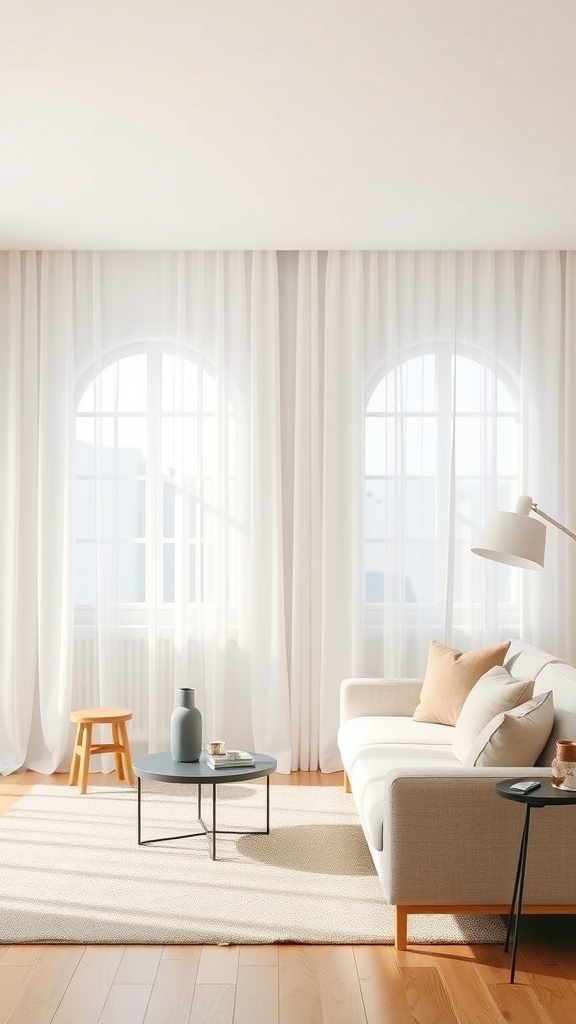
In a minimalist living room, window treatments play a key role in maintaining the clean and airy feel of the space. The image showcases large, soft curtains that gently frame the windows, allowing natural light to filter through. This choice enhances the openness of the room while providing a touch of softness.
The sheer fabric of the curtains creates a light and breezy atmosphere, making the space feel inviting. They complement the neutral tones of the furniture and flooring, blending seamlessly into the overall design. Simple window treatments like these can elevate a minimalist aesthetic without overwhelming the space.
Choosing light colors for curtains can help reflect sunlight, brightening the room further. It’s a great way to keep the focus on the beautiful architecture of the windows while ensuring privacy when needed. Minimalist window treatments are all about simplicity and functionality, making them a perfect fit for this style.
Strategic Lighting Solutions
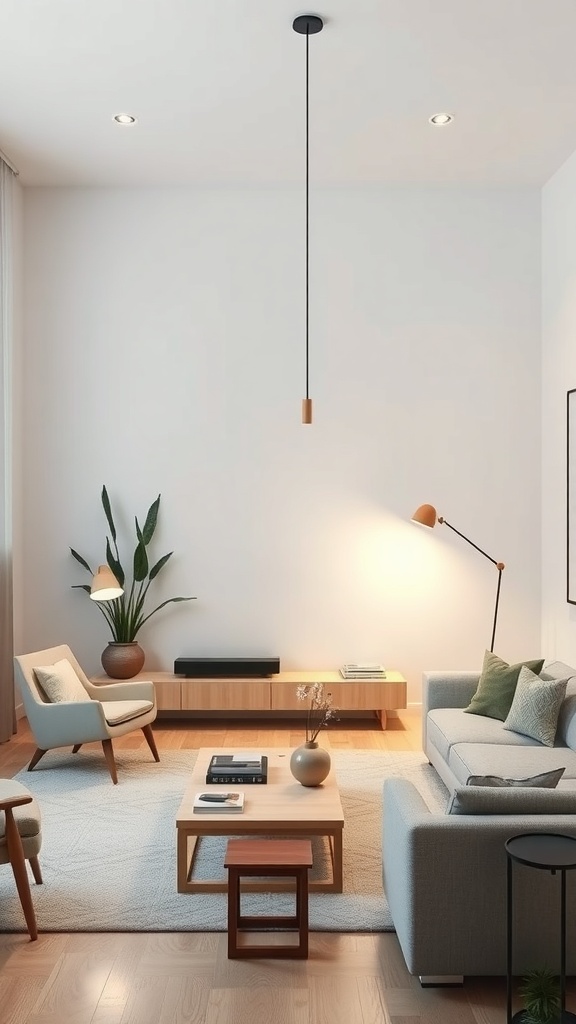
In a minimalist living room, lighting plays a key role in creating a welcoming space. The image showcases a well-lit area with various light sources that enhance the room’s simplicity.
The pendant light hanging from the ceiling draws attention without overwhelming the space. It provides focused illumination, perfect for reading or relaxing. The floor lamp next to the seating area adds a cozy touch, making it ideal for evening gatherings.
Recessed lighting in the ceiling offers a clean look while ensuring the room is bright and inviting. This type of lighting is subtle yet effective, allowing the design elements to shine without distraction.
Natural light also plays a part, with large windows letting in daylight. This combination of artificial and natural light creates a balanced atmosphere, making the room feel airy and spacious.
Maximizing Vertical Space
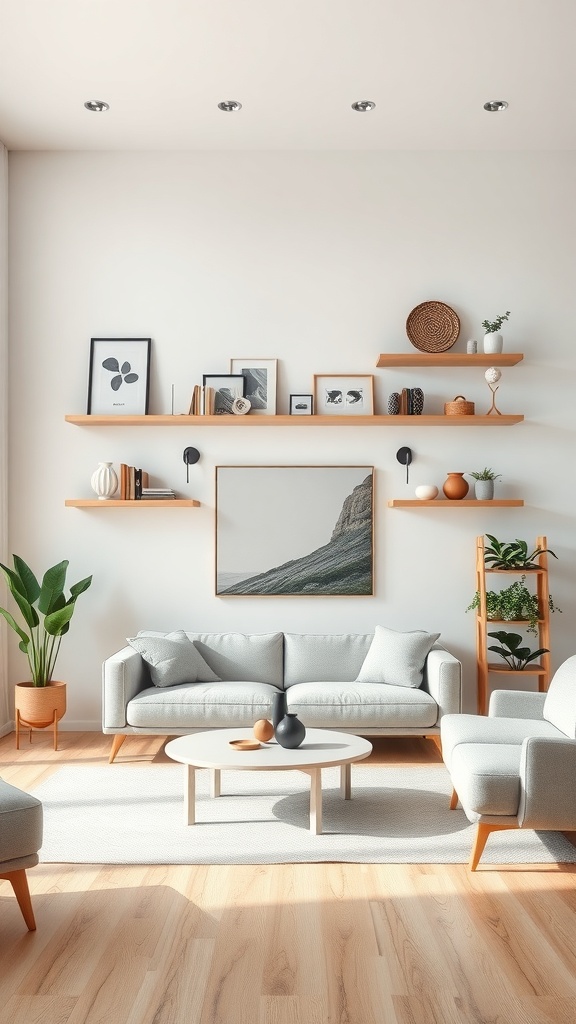
In a minimalist living room, using vertical space is key to creating a clean and open feel. The image shows a well-thought-out arrangement that takes advantage of the walls. Shelves are mounted high, displaying art and decorative items without cluttering the floor.
The light wood shelves contrast nicely with the white walls, making the room feel airy. This design choice draws the eye upward, creating an illusion of height. The plants and decorative pieces add life, while the furniture remains low-profile, keeping the focus on the vertical elements.
By using wall-mounted shelves, you can store books and display personal items without sacrificing floor space. This approach is perfect for small areas, allowing for both functionality and style. A few well-placed items can make a big impact.
Creating Zones in Small Spaces

In a minimalist living room, creating zones is key to making the most of a small space. The image shows a cozy setup with a light-colored sofa and a simple coffee table, which helps define the seating area. This arrangement invites relaxation and conversation.
Notice how the soft lighting and neutral tones create a calm atmosphere. The addition of a plant adds a touch of nature, making the space feel more inviting. The wooden furniture complements the overall design, providing both style and functionality.
Using rugs can also help delineate different areas. In this room, the rug under the coffee table visually separates it from the rest of the floor, enhancing the cozy feel. This simple trick can make a small living room feel more organized and spacious.
Don’t forget about vertical space! The curtains and wall art draw the eye upward, creating an illusion of height. This is especially useful in smaller rooms where every inch counts. By thoughtfully arranging furniture and decor, you can create distinct zones that serve different purposes while maintaining a cohesive look.
Personalized Minimalism
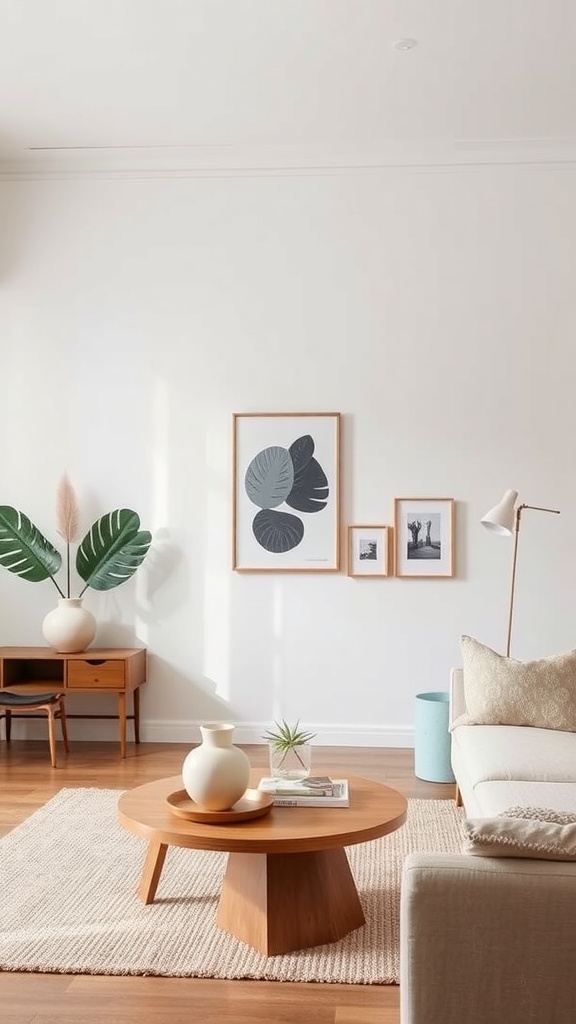
This living room perfectly captures the essence of personalized minimalism. The clean lines and neutral colors create a calm space, while the carefully chosen decor adds a personal touch.
The large leaves in the corner bring a hint of nature indoors, making the room feel fresh and inviting. The artwork on the wall, featuring simple yet striking designs, adds character without overwhelming the space.
The wooden coffee table serves as a functional centerpiece, balancing style and utility. The soft textures of the rug and cushions invite comfort, making it a cozy spot to relax.
In minimalist design, every piece has a purpose. This room showcases how you can express your personality through thoughtful choices, creating a space that feels uniquely yours.
Cohesive Design Elements
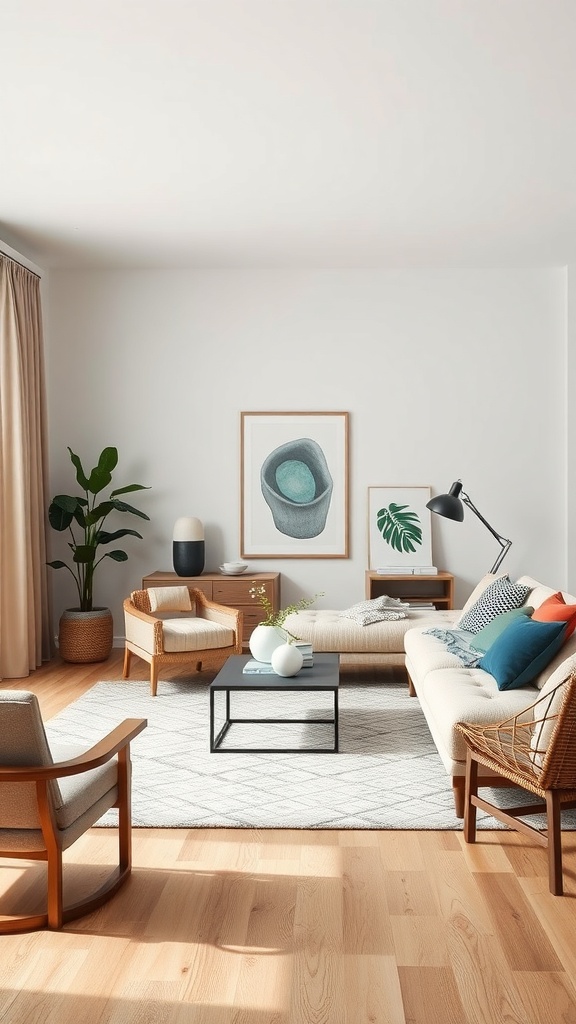
This minimalist living room showcases a blend of simplicity and style. The light wood flooring creates a warm base, while the neutral walls enhance the airy feel of the space. A large area rug adds texture and defines the seating area, making it inviting and comfortable.
The furniture selection is key to the cohesive design. The sofa, with its clean lines and soft cushions, invites relaxation. Accent chairs in natural materials complement the sofa, adding a touch of warmth. The use of a simple coffee table keeps the focus on the overall layout, allowing for easy movement.
Art pieces on the walls bring personality to the room without overwhelming it. The subtle colors in the artwork tie in beautifully with the cushions on the sofa, creating a harmonious look. Plants add a splash of greenery, enhancing the fresh and vibrant atmosphere.
Lighting plays a crucial role too. A stylish floor lamp provides both function and flair, illuminating the space while maintaining the minimalist vibe. Each element works together, making the room feel balanced and thoughtfully designed.
